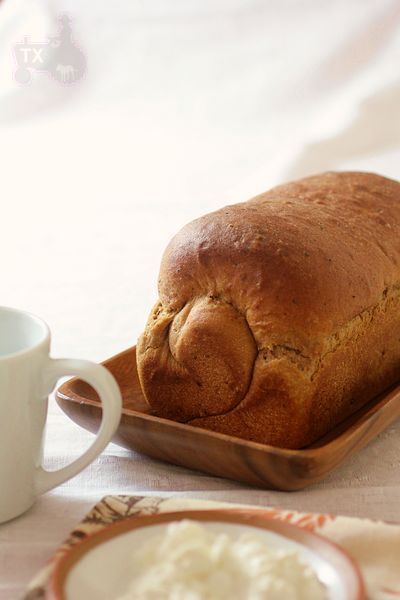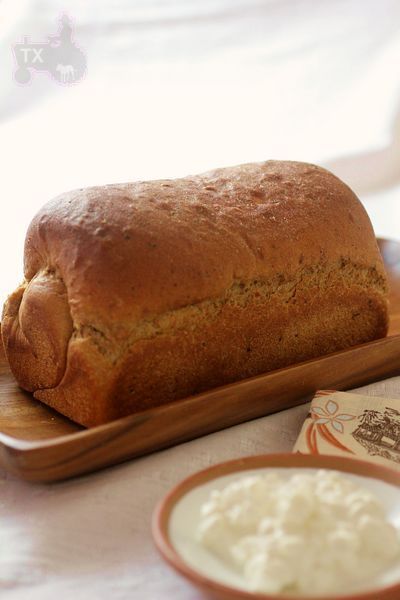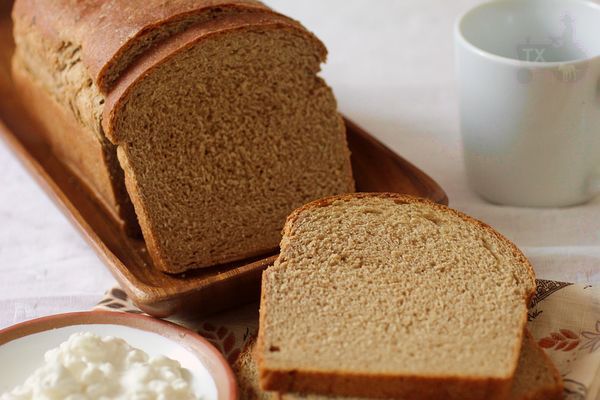
100% WW cottage cheese lemony sandwich loaf - my sourdough starter declares defeat!

This recipe is adapted from "Laurel's Kitchen Bread Book", my favorite WW bread book. There's nothing wrong with the formula itself, other than needing quite a bit more water, however, my attempt to convert it to sourdough has failed completely. Oh, don't think I haven't tried many time. Different rising schedule, different starter ratio, different cottage cheese, even added baking soda to offset the acidity of cottage cheese, they all ended up the same: the dough started tearing and collapsing 3 to 4 hours into the rise, no ovenspring to speak of.
2 huge tubs of cottage cheese later, I declare defeat. Here's my guess on why this formula doesn't work with sourdough, but I am in no way certain, and welcome all advices and theories!
- cheese has extra protease
- this formula has quite a bit of cottage cheese mixed in as part of liquid (35%)
- since it's part of liquid, cottage cheese were kneaded into the dough from the start, so it's very integrated into the dough structure
- using sourdough starter, my rise schedule is way longer than the 3 hours in the original formula. The loaf in the picture were made according to original formula with instant yeast, as you can see, there's no gluten break down, the loaf is tall and proud. so I guess my sourdough verion simply takes too long to rise, giving extra protease enough time to destroy the gluten structure.
- I could try to reduce the cottage cheese ratio, or shortened the rising time, but then that defeat the purpose of making pure sourdough verison of THIS formula
Anyway, here's the (slightly adapted) original formula and pictures using instant yeast, the bread is very delicious, even without sourdough.
Lemony Loaf (adapted from "Laurel's Kitchen Bread Book")
*formula is good for a 8X4inch loaf pan
ww flour, 413g
wheat germ,14g
instant yeast, 3.5g
water, 247g
cottage cheese, 145g
honey, 21g
butter, 14g
salt, 5.5g
lemon zest, from one lemon
1. Mix cottage cheese, honey, and 120g of water, heat to almost boiled, well mixed. Cool to room temp.
2. Add the rest of cold water, flour, wheat germ, yeast, salt, lemon zest, autolyse for 30min. Knead well, add buter, knead until past windowpane.

3. Rise at 80F for 1.5 to 2 hours until double, press with finger the dough won't bounce back. Punch down, and rise again until double, it will take half of the time as the first rise.
4. Shape and put in a 8X4in loaf pan
5. Rise at 90F until the dough is about 1inch above the rim, slowly bounce back a bit when pressed. About 45min to 1 hour.

6. Bake at 350F for 45min. Brush with butter when warm

You can't taste cottage cheese perse, but it does make the crumb very soft. This effect makes me wonder whether it also completely "breaks down" the gluten given enough time.

As delicous as this loaf is, the questions are still nagging me: "WHY exactly has my sourdough version failed?", "Can it work somehow?"
Submitting to Yeastspotting.


Comments
This Bake is fabulous! Txfarmer!
It may well be the protease in the cheese. Cottage cheese has loads of active proteases, as opposed to heat treated yellow cheeses.
But, Who wants a sourdough, when you have such a flavorful and nutritious loaf! Unless you plan to eat a healthier masonry block?
Cottage cheese has loads of active proteases, as opposed to heat treated yellow cheeses.
Really? I suspected that but don't know for sure. Do you have info about protease content in different cheeses?
sourdough yeasts have a really hard time being fast enough raise the bread before the protease destroys the gluten. In your bread above total fermentation and proofing time is only 3 to 3 1/2 hours or so. No doubt your sourdoughs are going much longer. Delaying adding the cottage cheese as long as possible would help but????would probably be unlikely to solve the problem. My recent post on protease failure related to blue cheese provides more details if you missed it.
An interesting hybrid might be to make a levain with part of thewater and flour and presoack the rest of the flour to get more flavor. Then mix and finish the final dough much as above using IDY to spike the yeast (though you could probably reduce the amount slightly). Ought to get close to sourdough flavor and "work".
Thanks for sharing.
Jay
Yeah, I did read your post about blue cheese, sounds like we had similar issues. Making a preferment may help indeed!
This is another interesting formula and looks great as always.Txfarmer. I don't have cottage cheese right now.. but I have plain yogurt.. Do you think that I could use it instead of cottage cheese? I like soft whole wheat bread!
Thank you for posting this, Txfarmer!
Best wishes,
Akiko
She does have a yogurt loaf in her book, with slightly different ratios though, but you can certainly try to convert this one to yogurt, I don't see why not.
txfarmer, you take great photos, I'm always amazed. I can tell it's your post just from your photos. thanks for sharing, they are inspiring.
so what's the texture & flavor of the "fail" loaves? I'm assuming you're trying to match the texture & flavor to the recipe which uses commercial yeast...to which my question would be "why?" :)
your explanation sounds right to me, the sourdough speed is not sufficient to match up with the recipe.
My sourdough version was not trying to duplicate the original flavor, but to improve upon it. I love the sourdough tang, both in lean heart breads and enrich breads. Especially after trying sourdough panettone, pandoro, challah etc, I was hooked. The richness + slight tang in the background creates a very complex flavor. Since than I have been converting lightly enrich sandwich loaves (both white and ww) to sourdough, with good results. Until this one. Oh well, can't have them all. :P
Hi Txfarmer,
I have baked this recipe of Laurel's in the past using IY too.
I decided to give it a try using SD to see if I could get it to work as I prefer using sd with all of my loaves.
I am familiar with your usual routine for baking with 100% ww flour and I assumed that was the route you were taking when attempting this recipe so I knew if you couldn't make it work - I wouldn't be able to either.
So, I decided to combine your method with Peter Reinhart's method for working with 100% whole grain doughs to see what would happen. ( I always soak my whole grains as it improves the flavor and makes the resulting bread easier on the digestive tract :-) The results were great! No dough breakdown or tearing. In fact, it created a really strong dough that held up well baked in my Pullman pan and the 2 small boules I baked free form.
What I did:
I created a leaven and a soaker last night using part of the flour and water in the recipe. Leaven contained 16% of the total flour @ 60%HL. The soaker contained 56% of the flour and all of the remaining water in the recipe plus the 2 eggs and all of the salt (8g).
This morning I heated the powdered milk up with the cottage cheese (I used Nancy's Cottage Cheese as it had no extra ingredients in it.) to 165° and then let it cool down before adding all of the remaining ingredients including the soaker and the leaven. I had to add a bit of extra water too to get a softer and more elastic dough. All were kneaded in my DLX until I got a strong widowpane.
Bulk ferment lasted approx 3 hours at about 75°. I could have let it go longer but was afraid of the dough breaking down...
Proofing for the 2 small boules = 1 1/2 hours while the Pullman pan loaf proofed for 2 1/2 hours at the same temp.
The oven spring was really good and loaves came out looking and smelling great....will have to see what the family thinks when they cut into the large loaf.
I did add 2g of IY in the final mix only as a precaution based on the results you got...I really didn't want the dough to disintegrate on me....I have had that happen enough times :-0 but next time I bake this loaf I know I won't add it as the dough handled everything really well.
I am thinking that using the soaker for part of the grains is what made the difference. Due to the salt added there were no rampant enzymes breaking down the dough so the dough remained strong and the gluten was already partially developed by morning. The leaven was also strong due to the low hydration.
I am relieved that I didn't end up with flat and dense loaves :-) This recipe really does make a wonderful light loaf and the sd only makes it that much better.
Thanks for all of you work that went into your loaf - saved me a lot of experimenting.
Hope you give the sd another try.
Take Care,
Janet